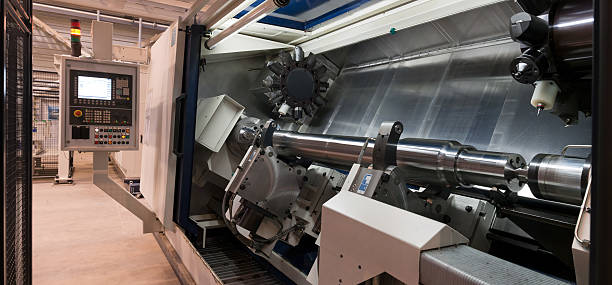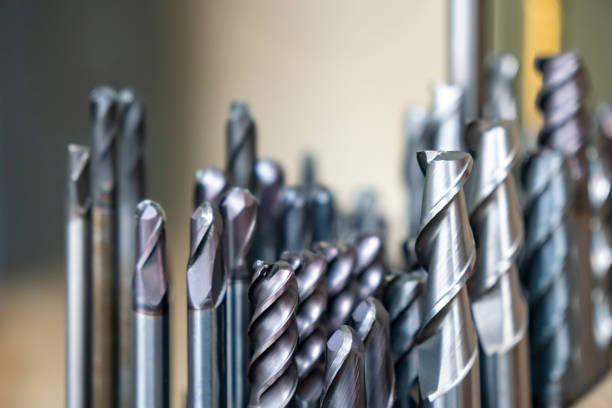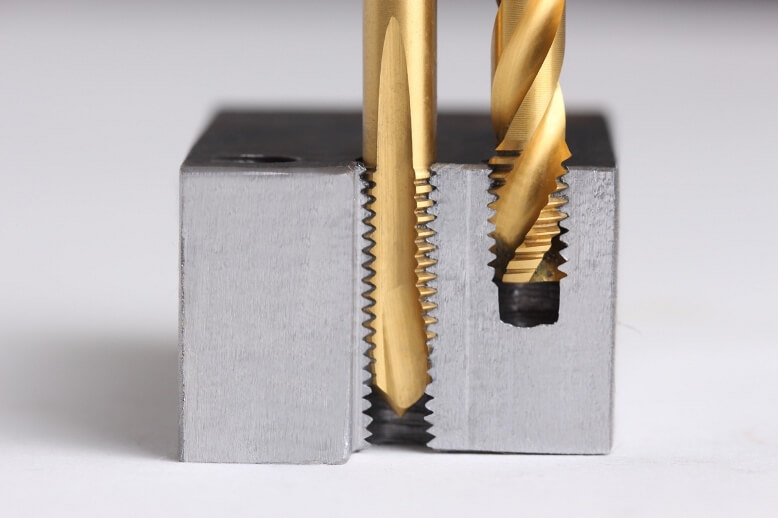It is imperative to fine-tune as many aspects as possible of your Tapping Program in CNC Turning Machine. Dial in and parameters settings are very crucial to produce accurate results.
This blog is going to discuss several important techniques. Improve productivity with these tips from our specialists.

A tapping program in a CNC turning machine controls accurate threading. This method helps to produce accurate internal threads. With G84, the tapping cycle is started. This means that each spindle rotation is equivalent to the thread pitch. It regulates feed rate and depth of feed.
Threads are created efficiently. When tapping in a consistent manner, error rates are reduced. These programs are used by operators. That is useful for producing threaded holes. Tool longevity is enhanced. Optimal tapping programs reduce time. In summary, they increase machine dependability.
Tapping programs are critical in CNC turning machines. They make it possible to create specific threads as required. G84 is often used in tapping cycles. Maintaining the spindle speed in synchrony will guarantee precision. It has versatility in dealing with different thread sizes.
Feed rates are controlled by CNC software. Every program is designed to perform specific functions. Internal threads require close management. Tapping enhances CNC versatility. Operators follow detailed instructions. High-speed tapping is possible. These programs enhance manufacturing productivity.
Turning programs in CNC tapping guarantee the required thread dimensions. Every cycle, which is governed by G84, contributes to improving consistency. Synchronization of spindle speeds is necessary. Good threads enhance product quality. Misalignment is minimized. Depth and pitch are controlled accurately by programs. This leads to formation of uniform threads.
This shows that quality affects the finished parts. Tools endure less wear. Tapping enhances the thread strength if it is done properly. Customers demand high-quality threads. Such expectations are met by reliable programs.
Implementation of programs in CNC turning machines increases productivity. G84 regulates the tapping cycle. Spindle speed is directly proportional to feed rate. This ensures precise threading. Effective tapping leads to decrease of the time spent on production.
Programs minimize manual adjustments. CNC software optimizes performance. Consistent threading enhances output. Tools last longer because they are precise. There is less rework when there are fewer errors. Efficiency gains are significant. Tapping programs streamline operations. Overall productivity increases.
Knowledge of different materials is significant in CNC turning. All the above mentioned materials possess different characteristics. For instance, aluminum is relatively malleable, whereas stainless steel is comparatively more rigid. This affects tap choice.
Some taps are suitable for brittle materials. Others suit ductile ones. Taps and materials should be compatible. It results in tool wear due to some right selections. For example, when using titanium, special taps must be used because of its strength and hardness. It is essential to make the right choices for the best results.

Some characteristics affect the efficiency of tapping as explained below. It explicitly means that the form and geometry of threads do matter. For instance, the spiral flute taps are suitable in blind holes. Coatings such as TiN improve the lifespan of the surface. The tap diameter plays a role in influencing the quality of threads that are created. Pitch controls threading precision.
High-speed steel (HSS) taps are also resistant. Carbon steel taps are suitable for operations that are not very rigorous. Lubrication improves tap life. Consequently, each feature makes a perceived contribution towards the overall effectiveness.
Spiral point taps are best suited for through-hole applications. Their design leads chips ahead. This prevents clogging. Employ them when using high-speed steel for greater durability.
They help to facilitate cutting of threads. Feed rate is also critical. Over-speeding causes breakage. Optimal RPM enhances results. Their flutes are angled. This reduces torque. They have been able to offer consistent performance.
Forming taps create threads by displacement. They need no chips. Use with specific lubrication. They generate less friction. Requires precise hole size. Diameter control is key.
Changes in RPM improve thread quality. Their design reduces breakage. High-speed applications benefit most. Some of the advantages include; they provide long tool life. Their forte is the efficiency in forming.
Choosing the correct tap is critical. Consider material type first. It is recommended to match the geometry of the tap with the application it will be used in. Check the thread specifications. Ensure correct tap size. Determine the RPM potential of the machine. Factor in hole depth.
Blind holes require special taps. Monitor tap wear regularly. Fine tune speeds for efficiency. Proper selection maximizes efficiency.
First, make sure your workpiece is clamped securely. Next, align the tap with the spindle. Ensure that the collet is tight. Feed rate should be set correctly. Use appropriate coolant. Confirm tool length offset.
Program the correct pitch. In this operation, spindle speed should be adjusted according to properties of working material. Check the tapping cycle parameters. These steps prevent errors.
Begin with zero-point calibration. Check the spindle alignment with the help of dial indicator. Make sure the workpiece is flat. Look also into the concentricity of the tap. Misalignment causes thread issues.
Inspect the tailstock alignment. Check whether the chuck grips the workpiece tightly. If deviations are identified then realign. Regular checks ensure precision.
Adjust spindle speed according to tap material. For HSS taps, use 500 RPM. Slow down when working with harder materials. Excessive speed leads to tap breakage. Monitor feed rate.
Optimal speed reduces wear. Set parameters using CNC controls. Verify settings before starting. Moderation in speed is important in order to avoid unnecessary troubles.
Synchronization ensures that tap and spindle move in harmony. Mismatch causes thread damage. Rigid tapping should be done using G84. Check if the feed per revolution corresponds to the thread pitch.
CNC synchronization settings should be checked on a consistent basis. Sync to avoid tap malfunction. Thus, proper synchronization means that the threading will be correct. Adjust if discrepancies occur. Precision relies on synchronization.
They include the following control of spindle speed using CNC settings. Set torque limits. Check the spindle load while tapping is in process. High load poses a problem.
Again, if required use spindle override. Ensure spindle runs smoothly. Efficient control of spindle improves the quality of threads. Check for abnormal vibrations. Maintenance causes spindle to remain in its best state.
Check out all the procedures before tapping. Check all programmed parameters. Make sure the chosen tap size is correct. To ensure that all apparatus is set, run a dry cycle. Inspect for any discrepancies.
Make necessary adjustments. Recheck all alignments. Check that the lubrication system is running. Final verification helps avoid mistakes that are costly.
G-code ensures precise tapping. Rigid tapping should be done using G84. S-code to set spindle speed. Explain how to use F-code to define feed rate. M29 turns on rigid tapping mode of the atomic force microscope. It is mandatory to check all the codes before running them.
Proper G-code reduces errors. The following parameter should be adjusted according to the material: Accurate g-code improves tap precision.
The code G84 is used to perform rigid tapping. It also controls feed and spindle speeds. Ideal for through holes, G74 is used for peck tapping. It deals with deeper holes through chip breaking.
Set correct retract height. Both cycles guarantee proper threading. Verify settings before running. It should be understood that usage of G84 and G74 increases machine productivity.
Set feed per revolution using G95 code. The feed rate must match the speed of the spindle. Appropriate feed reduces the rate of wear on taps. Feed rate should be adjusted to the hardness of the material.
Ensure that the setting has been correctly configured through test runs. Accurate control of feed rate enhances the quality of the threads. The feed rate must be constant for maximum efficiency to be achieved.
It is important to adjust the depth if one wants to be accurate. Specify depth for G-code in order to prevent over-tapping. Use precise measurements. Check the depth with the help of a gauge.
Adjust depth incrementally. Avoid exceeding material thickness. The correct depth should be maintained to avoid damaging the taps. Consistent depth guarantees consistent threads. Proper depth adjustment improves tapping dependability.

To improve tapping, make adjustments to the spindle velocity. The final setting speed depends on the tapping and the material used. For constant speed use G97. Increase RPM to avoid tap destruction.
Track spindle load when in operation. Excessive speed may harm taps. Proper speed enables efficiency. Speed should always be confirmed with test runs. Increased spindle speed provides improved tapping precision.
Tap life is greatly influenced by tool path. Straight paths ensure less stress is placed on the tap. Avoid sharp corners. Implement transitions between programs in G-code. Smooth tool path is not abrasive.
Minimize the entry and exit angles. Regularly check for alignment. Correct path planning leads to equal quality of the thread. This enhances tap longevity.
Wear limiting increases tap life. Use appropriate lubrication. That is why it is important to match the spindle speed to the hardness of the material being machined. Look for signs of wear and tear.
Prevent taps from failing on you by replacing them before they wear out. Slow down feed rate so as not to cause stress. Regular maintenance is essential. Improve G-code to lower friction. Taps that are less worn are likely to last longer.
Another factor that greatly determines the tap life is the feed rate strategy. Determine feed rate depending on the material. Use G95 for precision. Reducing the feed rate allows taps to last longer thus minimizing cases of breakages. Experiment with different rates in order to find out what rate is optimal.
Adjust as needed. The issue arises when it grows too fast or, on the contrary, develops too slowly. The feed rate should be appropriate to allow continuous tapping. This strategy increases tap life.
It’s possible to extend the tap life with proper practices. Use high-quality taps. Regularly inspect for damage. Maintain optimal spindle speed. Proper lubrication is essential. Adjust depth settings carefully.
Monitor machine performance. Replace worn parts promptly. Regular maintenance also helps to increase the tap life cycle. Effective practices ensure longevity. Maximize every component that would yield the best outcome.
Some of the methods used in lubrication improve tapping operations. Apply oils, coolants and pastes. Use directly on the tap. Ensure even coverage. Proper lubrication reduces friction. It prevents tap wear.
Always inspect these fluids and change them whenever necessary. In the correct method, the threading accuracy is improved.
Flood lubrication maintains a constant supply of coolants. It lubricates and cools the tap. It is ideal for high-speed tapping. It is used with materials like steel. Place the coolant flow rate to 50 liters per minute. This method prevents overheating. It reduces friction. Ensures longer tap life. Flood lubrication enhances performance.
Mist application uses a fine spray of the lubricant. Suitable for light tapping, it reduces lubricant consumption. Regulate the mist pressure to 2 bar. It cools and lubricates well. It is ideal for aluminum and soft materials. Mist application reduces friction. Prevents chip buildup, and ensures smooth operation.
High-pressure lubrication penetrates deep. Operating pressures should range from 0 to 70 bar. It removes chips effectively. Reduces tap breakage risk. Enhances cooling, and ensures consistent lubrication. High-pressure methods help to prolong the tap life. They improve threading precision. Use for demanding applications.
Proper lubrication procedures help in the longevity of the taps. Use high-quality lubricants. Apply them correctly. Regular maintenance is crucial. Monitor the tap condition. Replace lubricants as needed.
Lubrication should be adjusted according to the material type in use. Proper lubrication is important in order to have a smooth tapping process.
We've outlined effective strategy for managing your Tapping Program in CNC Turning Machine to enhance its performance. Lubrication and parameter adjustments help in increasing the tool life of the machine. Visit CNCYANGSEN for expert solutions. Implement these strategies today. Improve your CNC tapping skills. Start optimizing now!
